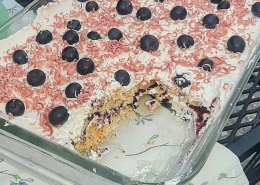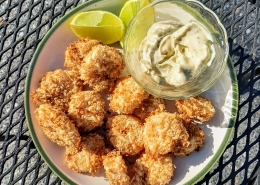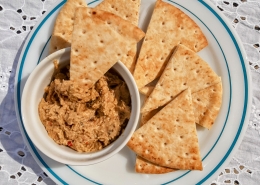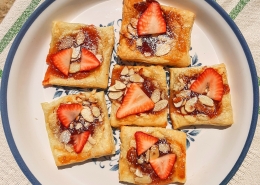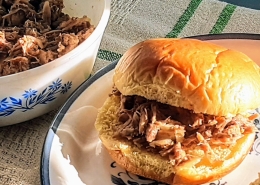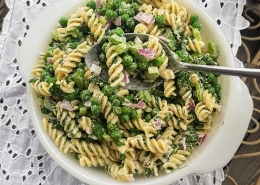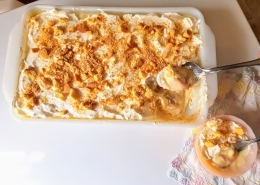Kitchen Promise for Earth Day
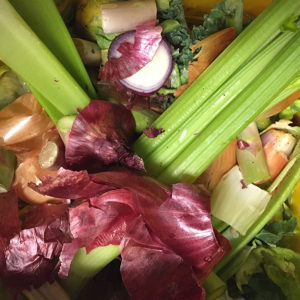 Zero waste is a great goal, although a bit difficult to achieve. However, we can all waste less if we put our minds to it. Just choosing one aspect to focus on can be a good way to start. If you’d like to waste less and use more of the food you buy, take a look at some of these suggestions and see what will help you in your quest for zero waste. Do it for Earth Day or, do it because it will save money!
Zero waste is a great goal, although a bit difficult to achieve. However, we can all waste less if we put our minds to it. Just choosing one aspect to focus on can be a good way to start. If you’d like to waste less and use more of the food you buy, take a look at some of these suggestions and see what will help you in your quest for zero waste. Do it for Earth Day or, do it because it will save money!
1. Use those radish and carrot greens
Buying radishes or carrots by the bunch? Use the leaves to make pesto, salads (like Moroccan Carrot Radish Salad), and toss in soup. Think of them as peppery parsley.
2. Savor broccoli and cauliflower stems
Do you discard broccoli and cauliflower stems? Peel the tough skin from the stems and chop the tender cores to use in the dish, or cut in planks to eat with dip.
3. Cook kale stems like you would celery
Do you discard kale and other greens stems? When cooking with kale, you can simply separate the leaves from the stems, chop the stems, and cook the stems first; they will cook a bit like celery. If you juice, save all your greens stems from meals you prepare, including parsley, and add to your juice for a chlorophyll boost.
4. Flavor stock and other dishes with potato peels
Do you peel potatoes? The peels make a flavorful addition to stock, and even thicken it a bit. Consider whether you even need to peel; many soups, potato salads and even mashed potatoes are more nutritious and filling with the skins left on.
Or, toss your clean potato peels with oil and seasonings and roast about 15-20 minutes at 400°F , stirring once half way through. Then sprinkle with cheese and green onions or serve with a favorite dip.
5. Enjoy the flavor and nutrition of apple peels
Baking or cooking with apples? Leave the skins on and you will reap the nutrients and fiber they contain, and save time. If you do peel, add them to soup stock, for a subtle sweetness.
6. Zest your citrus and freeze for future use
Juicing a lemon or lime, or eating an orange? Zest your organically grown citrus first, then freeze the potent zest in a freezer bag, for adding a hint of citrus to everything from muffins to pastas.
7. Peel overripe bananas and freeze for smoothies or baking
Are those bananas looking a little too brown to put in the lunch box? Peel and freeze them, then add them to smoothies (like Hidden-Spinach Berry Smoothie or Orange Dream Silken Smoothie), or thaw and puree for banana bread, muffins and cakes.
8. Puree and freeze veggies before they go bad
Do you have veggies going soft in the crisper? Cook and puree carrots, sweet potatoes, greens, cauliflower, and other veggies, then freeze. Stir the purees into pasta sauce, macaroni and cheese, soups, casseroles and meatloaf for an added veggie boost.
9. Save veggie trimmings for soup stock
Cutting up vegetables for a dish? Save and freeze the skins and trimmings from onions, carrots, celery, sweet potato, potato, parsley, spinach, and other mild veggies (peppers, cabbage and broccoli can be too strong) until you have a good amount to make Veggie Trim Stock.
10. Use up stale bread in flavorful recipes
Do you have bread going stale? Freeze the slices to use later in stuffing, croutons, or recipes such as Ribollita soup, Creamy Lentil Soup with Wheaty Croutons or Flexible Bread and Veggie Casserole. Make croutons for salads and soups, or crumbs to toss with pasta or top casseroles. Don’t forget about bread pudding and stratas, too.
11. Keep food that needs to be consumed soon front and center
Organize your refrigerator and pantry, and put foods that should be consumed sooner right in front. Switch your storage containers from opaque to clear glass, so that you will see that tasty lasagna from last night, because out of sight is out of mind.
12. Turn your vegetable scraps into fertilizer
Do you have room for a compost pile or a worm bin? Ultimately, transforming your plant waste into fertilizer is better than packing it in the landfill.

